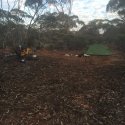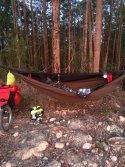I did the Trans Am Bike Race
I crewed on a RAAM (1987 - she won) so I have some idea of what a racer (and crew) will put up with to succeed. I don't want to take away from that at all, but many of the people who post here have that bent so I'll let them write about that approach.
I'm more speaking to the side of 'not luxury but not extreme'. I have an older body with some significant mechanical and health problems, but I still am exploring how to be light and compact - I'm posting about that. Here in Perth it's winter now, and temperatures are down to about 50F - it should get colder in a month or so. I'm working out my 'get home kit' - being the most compact to carry to ensure I stay healthy if I need to walk home some day and sleep out in the field to get there. We do have fires and very occasional floods and later I might live somewhere with other problems - also I can turn an ankle or worse and be forced to spend a night out.
I'm succeeding in sleeping through the night quite comfortably now with this set up:
SOL Escape Bivvy (either regular or Pro)
Sea to Summit Reactor Extreme liner
Wilderness Innovation Osni poncho liner/quilt:
Osni
I don't wear any clothes with this so my clothes don't soak during the night - no hat, no socks - this is enough insulation on it's own for deep sleep so far. I'll find out about colder later this year.
The Osni has the benefit of acting as a Great Coat when I'm up and around or sitting at the fire, and also matches their ponchos for weather protection. The poncho also serves as a tarp and as a gathered-end hammock - it's designed for all this - it's their main product in many fabrics.
In a compression sack, the Osni is about the size of a large coconut, but offers multi-use versatility. And it's got a warm hood!
You might do the same with another solution - there are other poncho liners. But I haven't used them.
I am about 6'-1.5". The SOL bivvy is marginal for me, but works - with my height it helps to stand up and put on the layers ensuring my feet are flat on the ground and pull the hood of the bivvy over my head and cinch (the hood only - not the front) so it stays in place before I lie down. Some taller people have complained the bivvy is too short online, so I'm mentioning that detail so you know it can work for my height and less.
It's also snug - dead space permits convection loss. My approach is to snug the drawstring to close the hood so it all stays on, but leave the front drawstring slack and just tuck the front in as a draft collar around my neck and face. It's quite easy to get out of the bivvy when I want to - just push it open.
You need the SOL Bivvy versions that have the word 'Escape' in the name - this is not about drama, it's about water vapour escaping through the fabric, and they work very well at this. At the same time, both versions stop rain very well although it can still get in through the opening - try turning over so the bottom/hood is on top.
The reflective coating inside the bivvy won't help if you are touching it - you'll get conduction loss then instead. You need some insulation between you and the bivvy for the coating to do its task, but it works well then.
Again, my criteria aren't focused on bike packing - I want to deal with twisting my ankle and falling in the river. As well I don't want to buy 8 sets of equipment for specific conditions - I am assembling
one solution I can be sure of and use for anything as it's light and compact - so I will have it with me. For this reason, I won't use down - it won't keep me alive if it gets wet. Staple fiber insulations are poor - Apex Climashield will handle any conditions and I've seen several testimonials of people who deliberately soak their Climashield bag and then sleep out in it - without squeezing the water out first. They say it's dry in the morning from their body heat. Wilderness Innovation uses this insulation.
My kit is not the most convenient (snug mostly), but it's very compact and it does the job. It's not aimed so directly at what you asked about, but there may be some useful ideas for you.
If you are interested, but taller than me check out
2GoSystems and their Arc bivvy.
I also recommend Wiggy's sleeping bags, but they won't satisfy the bike packing extremes unless you're thinking of going out with serious snow on the ground - then they will justify their bulk (and they can be smashed really small for their size over and over - they
will loft again).





